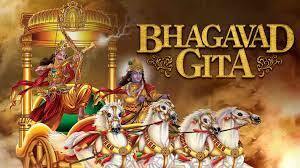The Bhagavad Gita: Translated 1000 Times in 75 Different Languages
Episode 8 Dharma in the Bhagavad Gita
A History of India
Michael Fisher (2016)
Film Review
The Bhagavad Gita (The Lord God’s Song) is the section of the Mahabharata (see Deciphering India’s Oral History Through the Mahabharata) that receives most attention in the West.
Throughout his career, Gandhi quoted and expanded to promote its non-violent teachings. Ironically his assassin Nathuram Godse also used it to help plan the assassination.
The Gita has been translated 2000 times into 75 languages. In Sanskrit alone, there are 225 different commentaries on its meaning. It was first translated into English in 1785, and Ralpha Waldo Emerson, Walt Whitman, Robert Oppenheimer (war-time head of Los Alamos laboratory), John Coltrane and classical composer Philip Glass were all big fans. Tulsi Gabbard, the first practicing Hindu in Congress, took her oath of office on the Gita.
In the Gita, the hero Arjuna is extremely reluctant to slaughter cousins competing with him for the throne. For this reason the god Krishna, posing as his chariot driver, takes him into no-man’s-land and explains the the cosmos and the relationship between men and God. The shortest book in the Mahabharata, the Gita is 700 verses long and takes 90 minutes to recite in Sanskrit.
Historians believe it was probably composed on 200 AD. Because it was less sacred than the Vedas, scholars were allowed to edit the Mahabarata. Recorded on palm leaves, Fisher believes the original only survived two to three generations. He also suspects edits occurred with each new copy that was made.
The 1968 translation of the Gita by Swami Prabupada would lead to the formation of the International Society for Krishna Consciousness (the Hare Krishna movement), which at its height had 23 million members.
It enunciates the following basic principles:
Because all life is impermanent, people should not fear death.Killing to achieve a higher principal (ie liberation, to end immorality) isn’t necessarily wrong.Individuals misperceive themselves as separate from Brahman, the universal being or oneness.Making an issue of killing/dying violates the essence of oneness, as only death allows the soul to reunite with the universal oneness on which all being is based.One must act in the world without desiring consequences, a state of mind achieved through yogas (ie disciplines).*armic yoga – each person needs to selflessly follow their own specific duty and code of conduct (eg because members of the Kshatriyas varna are obliged to do battle, they don’t commit evil when they kill).**Jnana yoga – acting in the world while fully understanding the transitory nature of existence makes moral doubts disappear.Meditative yoga – meditating allows people to release desire, fear and anger, making moral doubts disappearBhakti yoga – total devotion to the divine protects us from susceptibility to human desires.***The word yoga comes from the same root word as the English word yoke.
**Krishna himself was born into the Kshsatriya varna (see The Vedic Origin of India’s Castes)
***This concept was new with the Gita and for the first time opened the path of devotion to all human being regardless of their birth status (Ie it was no longer limited to members of the Brahmin varna). Following publication of the Gita, the route to devotion no longer depended on Vedas, Brahmins or ritual sacrifice.
The https://pukeariki.kanopy.com/en/pukeariki/video/366254/366187
The Most Revolutionary Act
- Stuart Jeanne Bramhall's profile
- 11 followers




